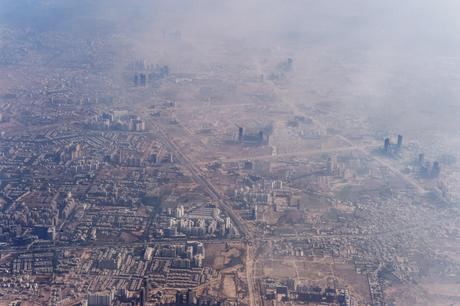GR: Here’s some good news. In a surprising development, India has begun moving from coal to solar energy. The country’s air-pollution problems are part of the reason. The rapid decline in the price of solar power is also a factor.

Smog enveloping buildings on the outskirts of New Delhi in November 2014. Credit Roberto Schmidt/Agence France-Presse — Getty Images
The next bit of good news I would like to see is a decline in India’s population. In the words of Indian conservationist Dr. K. Ullas Karanth, “India is renowned as the land of the tiger and the elephant; many of our gods are depicted riding peacocks or tigers. But sadly, the equation that existed between people and wildlife centuries ago has vanished, and our protected areas, which comprise a mere 4 percent of India’s landscape, are now mere islands amidst a sea of people, with tremendous demands and pressures being put upon them.”
MUMBAI, India — “Just a few years ago, the world watched nervously as India went on a building spree of coal-fired power plants, more than doubling its capacity and claiming that more were needed. Coal output, officials said, would almost triple, to 1.5 billion tons, by 2020.
“India’s plans were cited by American critics of the Paris climate accord as proof of the futility of advanced nations trying to limit their carbon output. But now, even as President Trump pulls the United States out of the pact, India has undergone an astonishing turnaround, driven in great part by a steep fall in the cost of solar power.
“Experts now say that India not only has no need of any new coal-fired plants for at least a decade, given that existing plants are running below 60 percent of capacity, but that after that it could rely on renewable sources for all its additional power needs.
“Rather than building coal-fired plants, it is now canceling many in the early planning stages. And last month, the government lowered its annual production target for coal to 600 million tons from 660 million.
“The sharp reversal, welcome news to world leaders trying to avert the potentially deadly effects of global warming, is a reflection both of the changing economics of renewable energy and a growing environmental consciousness in a country with some of the worst air pollution in the world.
“What India does matters, because it is the world’s third-largest emitter of greenhouse gases, behind China and the United States. And its energy needs are staggering — nearly one-quarter of its population has no electricity and many others get it only intermittently.
“With India’s power needs expected to grow substantially as its economy continues to expand, its energy use will heavily influence the world’s chances of containing the greenhouse gases that scientists believe are driving global warming.
“Much attention at the time of the signing of the Paris agreement was focused on the role President Barack Obama played in pushing India’s prime minister, Narendra Modi, to sign. In doing so, Mr. Modi committed India to achieving 40 percent of its electricity capacity from nonfossil-fuel sources by 2030.” –Geeta Anand (Continue reading.)

